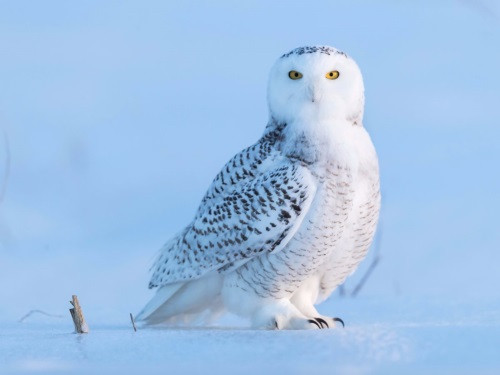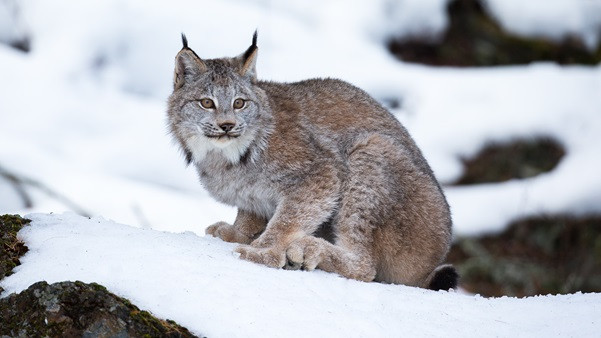Interesting facts about animals living in the Arctic
The North Pole, millions of kilometers wide, is covered year-round by cold frost. Despite the harsh conditions, there are many living animals and their behavior makes you surprised.
The Arctic region is the northernmost part of the Earth. This is where the Sun only grows and dives once a year, once the Sun has risen, it will shine for six months, while if the Sun has set, this whole land is dark for the remaining half year. . In winter, rarely do temperatures exceed 0 degrees Celsius, trees cannot even grow but the animals are quite rich.
In the winter months, the average temperature of the Arctic region is -20 ° C. In fact, this place often hits -50 ° C and that's not the lowest heat level ever achieved in this place. Just as strong winds blow very often with bone-chilling cold air.
With such harsh climatic conditions, many animals such as bears, cats, wolves, weasels and other birds and mammals live here for a long time and have adapted to cold living conditions. This price; and they are very unique species but also beautiful.

The snow owl cannot be confused with other owl species in the world.(Photo: Shutterstock).
Most Earth owl species sleep during the day and work at night, but the arctic snow owls have the opposite activity. The reason is because the night here is very cold, as well as many animals in the daytime are the food of snow owl when waking up.
As a bird of prey, the diet of snow owls is mainly Lemming mice (a small rodent animal that lives in cold climates). In fact, a snow owl family can eat up to 1,500 Lemming mice before the mature snowfall and new family.
Snow owls are very quick and healthy birds, they fly very fast and this speed can cause an adult to fall if accidentally collided with it.

In other languages, the name 'Arctic' is derived from this bear, not the other way around.(Photo: Reuters / Mathieu Belanger).
Polar bears are perfectly adapted to the Arctic region. In fact, the word 'arctic' (only the Arctic in English) is derived from the word 'arktos' (only the Greek bear). And indeed, only the white bears live in the Arctic region, not the bears that live in the Antarctic region, and the word 'Antarctic' (English only Antarctica) means the opposite.
The polar bear is extremely impressive. According to the World Wildlife Fund, a polar bear can smell the smell of a seal diving deep in the water or somewhere near a kilometer away. Or even when an animal passed and left footprints, the bear was still recognizable.
Beard seals

The beard is a professional singer in the polar animal world.(Photo: Shutterstock).
The bearded seal has a very strong head. With a rigid head, it can smash thick layers of ice on the lake surface for air circulation with the top or to get under the water.
They can sing with ultrasound. The male makes a sound when swimming in the water to attract the attention of the females during the mating season. The human ear cannot be heard because it is beyond our hearing threshold, but modern technology devices can be recorded, and the sound sounds strange and haunting.

A white whale at the Vancouver Institute of Oceanography, Canada.(Photo: Shutterstock).
The forehead of the white whale is very special, it can change the shape of the forehead by circulating air in the sinus lobe. Making the forehead bulge to help the white whale emit sound waves and get back the reflected waves to map and locate the path to the surrounding area.
According to the US National Whale and Dolphins Conservation Bureau, white whales are called canaries of the sea, because they can produce at least 11 different sounds for different purposes. taste, find people, or even imitate human speech sounds.

Canadian bobbins have natural snow boots.(Photo: Shutterstock).
Canadian primates have large feet with extended toes, allowing them to move easily on thick snow. Their feet are like our wooden loafers, which evenly distribute the body's mass to the limbs.
This snow lynx mainly eats snow bunnies, the rabbits are very fast, but the bobbins are even faster. The bobcat sat still and the prey for a long time, even for hours or even a whole day, then suddenly rushed to grab the poor rabbit.
Polar puffin seabirds

The name puffin is because they look like hairy bolls.(Photo: Reuters / Nigel Roddis).
The puffin seabird looks like newly hatched chicks or baby rabbits, with a lot of dense feathers and curled up like a cotton ball. These birds, though only about 25 cm tall, can find very good food and are always filled with food in the mine.
In fact, puffins can hold up to 10 fish at the same time and bring them to the nest in one go. The record was recorded by experts when a puffin living in the waters of England brought 62 fish at the same time.
The puffin seabirds stand out with their distinctive bright orange legs and beaks, but only during the breeding season, and often in the spring when the weather is getting warmer. During the breeding season, the orange parts of the body gradually shrink and its body becomes more gray.

Arctic snow foxes can change their coat color in different seasons of the year.(Photo: Shutterstock).
The thick coat of the Arctic fox can withstand extreme weather conditions with low temperatures here. In addition, the Arctic fox also has hair growing in the feet, making it easier for them to cross ice and snow.
In the summer months, the Arctic snow fox turns the color of the coat into brown or gray, they only have snow-white fur in the winter. According to the Canadian Geographic Agency, Arctic foxes are the only species that can change the color of the coat in different seasons.
Arctic Rabbit

Arctic rabbits are one of the most agile species because they always live in fear.(Photo: Shutterstock).
Polar rabbits can run at speeds of up to 65km / h, while the speed of Usain Bolt - the fastest runner in the world - is 37km / h in a distance of 100 meters. But it is not only impressive in speed.
If a rabbit realizes that it is threatened when a wild animal strikes, it will quickly recapture any limb into the body, then launch with only the remaining three limbs and quickly disappear, leaving only 3 footprints on snow face.

The horn is actually an extended tooth.(Photo: Shutterstock).
The poisoned fish, a single horned fish or narwhal, is known for its large horn that protrudes from the top of its head. Practically once recorded, the largest horn of the narwhal is up to 3 meters long.
These horns are actually big teeth, showing about 10 million neurons. This helps narwhal can recognize the feeling through the horn. The name 'narwhal' with 'nar' is a corpse and 'whal' (whale) is a whale, because it is white gray like a dead whale.

Arctic wolves develop their own fur to keep warm through the winter.(Photo: Shutterstock).
The thick fur of the Arctic wolves allows them to withstand negative temperatures. At the peak of winter when the temperature drops too low, they will grow a second layer of fur to keep it warm better.
The viability of this species is also remarkable, they can live healthy for 5 months in winter when there is no appearance of sunlight, while most other mammals start hibernating. .
Dall

The age of Dall sheep could be known from its horns.(Photo: Shutterstock).
Dall's horn grew long and curled into circles called annuli, the age of Dall sheep could be determined by relying on annuli. This is like the number of wood rings within the tree. It took seven to eight years for a Dall sheep to fully develop a pair of annuli.

The Arctic Circle is the bird that receives the most sunlight because they always fly away to avoid the winter cold.(Photo: Shutterstock).
The Arctic sea idlers are very active migrations, each year they fly about 40,200 km and are always visible in the summer. By winter in the Arctic, they will fly into a large herd to the south and enjoy the summer here. It is the most distant bird among birds.
Since they spend most of their time migrating and flying so far, this bird searches for partners and performs mating on the flight. A sea animal can live for about 30 years. So they will fly 2.4 million km - corresponding to three "rounds" from Earth to the Moon - throughout their lives.
- 15 interesting facts about animals are not included in textbooks
- A series of fun facts that answer your own eternal questions!
- Interesting facts about horses
- 10 interesting facts about world history
- 19 extremely interesting facts you should not ignore
- Interesting things about reindeer
- Anecdotes should not believe other animals
- Interesting facts in Germany
- Interesting facts about animals
- Discover interesting scientific facts
- Record of ... dogs
- 10 extremely interesting facts about clothes
 Animal 'suffering' after hibernation
Animal 'suffering' after hibernation Why do goats climb well?
Why do goats climb well? Scientists were surprised to see chimpanzees eating turtles
Scientists were surprised to see chimpanzees eating turtles Giant catfish died deadly due to drought in Thailand
Giant catfish died deadly due to drought in Thailand